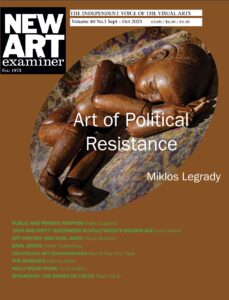
Retrospective dedicated to Jannis Kounellis, Ca ‘Corner della Regina, Venice, 11 May / 24 November 2019, curated by Germano Celant
 As soon as I entered the vast hall on the first noble floor of Ca ‘Corner della Regina (headquarters of the Fondazione Prada Venezia), I was struck by an array of hats, shoes, dark coats: I thought of people moving around the world, of migrations, of the Holocaust. In “Untitled” (2011), created by Kounellis a few years before his death in Rome in 2017, is an emotionally charged installation, an almost physical punch where the overwhelming presence/absence of the artist immediately catches the attention. It’s a feeling that accompanied me throughout the other salons of the splendid Venetian palace. Kounellis plays with all the materials of Arte Povera: wool, coal, fabric, iron, steel … every space surprised me in a different way: the “Fire Daisy” is an iron flower from whose center springs a flame, triggered by a gas cylinder. Fire is seen as a regenerative element and bearer of revolutionary energy, while the smoke and soot that cover stones, canvases and walls, represent the impossibility of affecting the social order through art.
As soon as I entered the vast hall on the first noble floor of Ca ‘Corner della Regina (headquarters of the Fondazione Prada Venezia), I was struck by an array of hats, shoes, dark coats: I thought of people moving around the world, of migrations, of the Holocaust. In “Untitled” (2011), created by Kounellis a few years before his death in Rome in 2017, is an emotionally charged installation, an almost physical punch where the overwhelming presence/absence of the artist immediately catches the attention. It’s a feeling that accompanied me throughout the other salons of the splendid Venetian palace. Kounellis plays with all the materials of Arte Povera: wool, coal, fabric, iron, steel … every space surprised me in a different way: the “Fire Daisy” is an iron flower from whose center springs a flame, triggered by a gas cylinder. Fire is seen as a regenerative element and bearer of revolutionary energy, while the smoke and soot that cover stones, canvases and walls, represent the impossibility of affecting the social order through art.
Fundamentally, Kounellis is a political artist, in the deepest meaning of the word; his works want to stir up society, revolutionize it.
The installation “Tragedia civile” (1975) is a testimony of a historical and personal crisis. A wall covered with thin gold leaf, the element that according to alchemical tradition is the ultimate result of combustion, contrasts with the black color of the garments (a coat and hat) hung on a coat rack. The presence/absence of the artist is felt very strongly also here.
Other works are based on the contrast of lightness, instability, cyclicality connected to nature and heaviness, artificiality and rigidity of man-made artefacts: they are symbols of the condition of living beings, caught between the desire for freedom and the cage of social constraints. Many works testify to this feeling which are the iron plates, inside which the artist has inserted hair, or where he has placed a fragile egg, or some wool …
The exhibition is also an olfactory experience: on a long wall, many small scales containing ground coffee are hung, while hundreds of grappa glasses support a heavy lead shape depicting Munch’s scream.
A dazzling green oil painting contains the notes of a pentagram from a sacred composition by Bach, which is performed live by a violoncellist. Here, too, Kounellis overcomes the traditional distinction between artistic language: image and sound merge; author and spectator share the same experience.
The artist proves he is an innovator and an experimenter also in his reuse of Greek-Roman art. A Greek by birth, he soon moved to Rome; his work is imbued with classicism, however he does not simply repeat traditional models, but transforms them, while keeping essential elements. On a marble table plaster fragments that are copies of ancient statues reproduce the ancient statuary: a hero’s profile, a hand, a raised foot (the Achilles heel?) and the drapery of a robe are the parts that our imaginary recognizes completing them into a whole.
Kounellis also focuses on different ways to hang an object. In one of his installations, wardrobes of different colors and shapes are hung horizontally from the ceiling with steel cables, almost a challenge to the law of gravity that gives us a reversed view of reality. In the courtyard of the building, seven metal plates hold bags of coffee beans in a verticality that seems endless.
The exhibition presents 60 works from Italian and international museums (1950 – 2015) and is a tribute to the master of Arte Povera. It reconstructs a path that, as the curator says, looks “like a maze, dear to Jannis, in which to get lost, finding the vitality of fragmented entities but capable of reflecting a continuum”.
Liviana Martin
volume 34 no 1 September – October 2019 p 24

